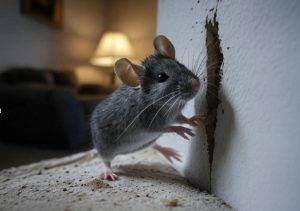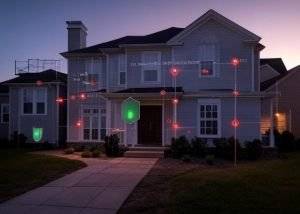Winter Isn’t Just Cold; It’s an Open Invitation for Rodents
Picture your home as a fortress, standing strong against the winter cold. But as the temperatures drop, an unseen army lurks in the shadows, rodents, relentless invaders searching for warmth, food, and shelter. If you wait until you see them, it’s already too late.
Winter is prime invasion season for mice and rats. The chill forces them to seek refuge; without a strong defense, your home becomes their kingdom. They nest in attics, chew through wires, and contaminate food, turning a minor oversight into a full-scale infestation before spring arrives.
Most homeowners take a reactive approach, scrambling to set traps once they spot droppings. But true protection comes from strategy, not desperation. Like a skilled general preparing for battle, you must fortify your home before the enemy arrives.
In this guide, we’ll arm you with the expert tactics to secure your home, seal entry points, eliminate attractants, and deploy strategic countermeasures. Because in the war against rodents, prevention is your greatest weapon. Are you ready to reclaim your territory? Let’s begin.
The Rodent Mindset: Survival at Any Cost
Imagine being a small creature, barely a few inches long, as the biting winter wind sweeps through the streets of Virginia Beach. Food is scarce, the cold is relentless, and every night is a battle for survival. This is the reality for rodents in winter; desperation drives their every move.

As temperatures drop, their instincts kick in: Find warmth. Find food. Find shelter. And to them, your home is a beacon of safety. Heated interiors, stocked pantries, and hidden crawl spaces make the perfect sanctuary. They are relentless in their pursuit, squeezing through gaps no wider than a pencil, scurrying along pipes, and clawing through insulation.
With their coastal climate and fluctuating winter temperatures, Virginia Beach homes offer the ideal conditions for infestations. Older homes often have cracks in foundations, while newer ones may have unsealed vents or open garages invitations rodents can’t resist. Once inside, they nest in attics, behind walls, and beneath appliances, multiplying at an alarming rate.
The urgency is real. One overlooked entry point, one night of warmth, and a single rodent can become an infestation. Their survival depends on your inaction. The question isn’t whether they’ll try to invade; it’s whether you’ll stop them before they do.
Know Your Enemy: The Three Rodents Invading Virginia Beach Homes

In the battle against winter infestations, not all enemies fight the same way. House mice are the covert spies, sneaking through the smallest openings and nesting undetected. Norway rats are battering rams, aggressive burrowers that chew through foundations and flood homes with destruction. Roof rats are acrobatic infiltrators, scaling trees and utility lines to breach attics from above. Each has a strategy; you must know theirs to defend your home.
- House Mice – The masters of stealth. These tiny intruders can squeeze through holes the size of a dime, nesting in walls, pantries, and insulation. They reproduce alarmingly, turning a single breach into a full-scale invasion within weeks.
- Norway Rats – The heavyweights. Larger and more aggressive, these burrowing rodents prefer basements and crawl spaces, gnawing through wood, plastic, and concrete. They contaminate food and spread disease, leaving a trail of destruction.
- Roof Rats – Agile and elusive, roof rats exploit overhanging branches and open vents to enter attics. They nest in rafters and eaves, making them harder to detect until major damage is done.
To win this war, you must outsmart them before they take over. The question is, is your home ready? Call Precision Pest Management Today.
Warning Signs: Catching an Infestation Before It’s Too Late
Rodents are masters of stealth, thriving in the shadows and striking when you least expect it. When you see one scurrying across the floor, you’re not dealing with a single invader. You’re in the middle of a full-scale infestation. That’s why early detection is critical. Knowing the warning signs can mean distinguishing between a manageable problem and a costly, full-home invasion.
Subtle Clues That Rodents Are Already Inside:
- Scratching and rustling sounds at night – Rodents are nocturnal. They’ve already settled in if you hear movement in the walls, attic, or under floors.
- Unusual pet behavior – If your cat or dog is fixated on a particular area, they may sense movement or scent trails you can’t detect.
The Obvious Red Flags:
- Droppings in cabinets, pantries, or along baseboards – Tiny, dark, pellet-like droppings are a clear sign of rodent activity.
- Gnawed wires, furniture, or food packaging – Rodents chew constantly to keep their teeth sharp, causing dangerous electrical hazards.
- Shredded nesting materials – Bits of fabric, paper, and insulation in corners or behind appliances mean they’re making themselves at home.
If you notice any of these signs, time is against you. Rodents reproduce rapidly, and waiting even a few days can turn a small problem into an infestation. The moment you suspect activity, it’s time to act.
The Defense Strategy: Fortify Your Home Like a Fortress

In the battle against rodents, the strongest defense is one they can’t penetrate. Rodents are relentless, squeezing through gaps no wider than a dime and scaling vertical surfaces to find weak points. If you leave even the smallest vulnerability, they will exploit it. Your mission? Fortify your home like a fortress, sealing entry points, eliminating resources, and making your space inhospitable to invaders.
1. Seal the Gates: Block All Entry Points
Rodents are escape artists, but more importantly, they are expert infiltrators. Walk around your home and inspect for gaps, cracks, and openings. You’ll be surprised at how small an entry point they need.
- Foundation & exterior walls: Use steel wool and caulk to plug cracks around doors, windows, and siding.
- Doors & vents: Install weather stripping and door sweeps to eliminate gaps.
- Utility pipes & AC units: Seal gaps with expanding foam rodents follow warm air leaks.
- Attic & roofline: Cover vents and chimneys with rodent-proof mesh to keep out climbers.
2. Starve the Invaders: Remove Food Sources
Rodents are drawn to easily accessible food; even the smallest crumbs can sustain them.
- Pantry & kitchen defense: Store all dry goods in airtight glass or metal containers.
- Trash & compost: Use bins with locking lids and regularly remove garbage.
- Pet food: Never leave food bowls out overnight. This is an open buffet for rodents.
3. Destroy the Nesting Grounds: Remove Hiding Spots
Rodents thrive in cluttered, undisturbed areas. The less cover they have, the harder it is for them to establish a foothold.
- Garage & attic cleanup: Keep storage elevated on shelves and use plastic bins instead of cardboard boxes.
- Yard maintenance: Trim back overhanging tree branches, ivy, and dense bushes, which provide easy pathways to your home.
- Firewood & debris: Store woodpiles at least 20 feet from your house and elevate them off the ground.
A fortress is only as strong as its weakest point. If you take these steps now, you’ll send a clear message to rodents: There’s no way this home is protected.
Tactical Countermeasures: The Art of Smart Elimination
Fortifying your home is the first line of defense, but what if the enemy is already inside? Rodent control isn’t just about setting a few traps and hoping for the best; it’s a strategic battle of intelligence, patience, and precision. Too many homeowners make critical mistakes that allow rodents to outmaneuver them. Here’s how to take a calculated approach to elimination and ensure victory.
1. Traps: The Frontline Weapons of Rodent Control
Traps remain one of the most effective tools in your arsenal if used correctly. The mistake most homeowners make? Placing traps in open spaces. Rodents don’t travel through the middle of a room; they stick to walls, behind furniture, and along baseboards. Optimal placement is everything.
- Snap Traps: Classic and effective. Place multiple traps 2-3 feet apart along known rodent pathways.
- Live Traps: Humane but require immediate relocation at least a mile away, or rodents will return.
- Glue Traps: Less effective for infestations; best used in tight crawl spaces where snap traps don’t fit.
2. Baiting: Using Psychology Against Rodents
Rodents are smart. If they sense danger, they’ll avoid unfamiliar objects, including traps. Bait traps without setting them for the first few nights to build trust. Use high-protein, aromatic foods like peanut butter, nuts, or bacon.
- Avoid using too much bait; rodents should have to step on the trigger to access it.
- Never handle bait with bare hands. Human scent can make them suspicious.
3. The Myth of Ultrasonic Repellents & Other Mistakes
Many homeowners fall for ultrasonic rodent repellers, believing they drive rodents away. The truth? They might work initially, but rodents quickly adapt. Likewise, poisons without a plan can drive rodents deeper into your walls, leading to foul odors and more problems.
4. When DIY Isn’t Enough: Calling in the Experts
If you see increasing signs of activity despite your best efforts, it’s time to escalate the battle. Professional pest control offers advanced elimination tactics and long-term prevention that outmatch even the craftiest invaders.
Rodent control is both a science and an art, a battle of wits between you and an opponent that adapts quickly. Stay strategic, stay patient, and take control before they do.
Why Professionals Always Win: The Power of Precision Pest Management
DIY rodent control can feel like a battle of wits, setting traps, sealing gaps, and hoping you’ve outsmarted your invaders. But the reality? Rodents are adaptable, elusive, and incredibly persistent. A few well-placed traps might catch a couple, but the infestation will continue behind the scenes without a comprehensive strategy.
This is where professional pest control changes the game. Experts don’t just react to the problem. They eliminate it at the source and ensure it doesn’t come back. Using advanced tools like infrared detection, exclusion barriers, and strategic baiting systems, professionals identify hidden nests, track movement patterns, and implement precision-targeted treatments that DIY methods can’t match.
Beyond elimination, ongoing prevention is key. Professional services provide routine inspections, long-term deterrents, and proactive measures to reinforce your home against future invasions. Homeowners who rely on DIY often find themselves stuck in an endless cycle, catching one rodent while a dozen more lurk in the shadows.
The biggest advantage? Time and peace of mind. Rodents can carry disease, cause costly damage, and disrupt your home’s safety. Instead of constantly battling an infestation, professionals handle the problem efficiently and permanently. You shouldn’t have to live in fear of what’s crawling behind your walls with expert help; your home stays rodent-free, and you stay worry-free.
Own Your Space: Take Action Now
Your home is your domain, and you can decide who enters. Rodents aren’t just a nuisance. They’re invaders, threatening your health, safety, and peace of mind. But you don’t have to wait until you see one to take control.
By sealing entry points, removing attractants, and setting smart traps, you can create a fortress that keeps rodents out for good. And if you want guaranteed protection, professional pest management ensures fast, safe, and lasting results.
We’re offering a FREE winter rodent inspection to help you identify vulnerabilities before they become full-blown infestations. Don’t wait until the scratching in your walls keeps you up at night. Act today!
📞 Call 757-854-9177 to claim a free inspection and secure your home before rodents do. Your space. Your rules. No exceptions.

